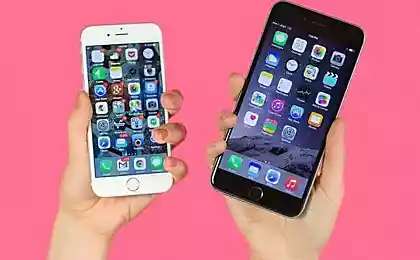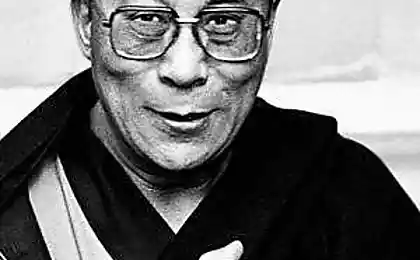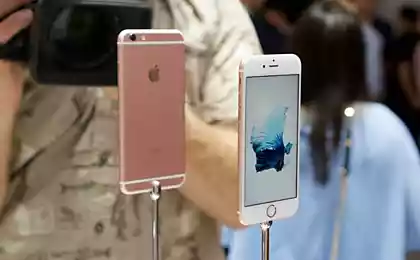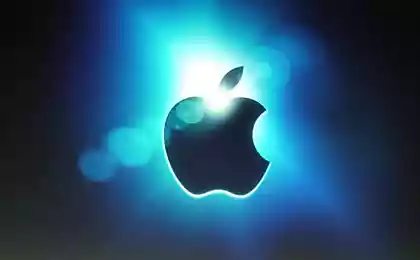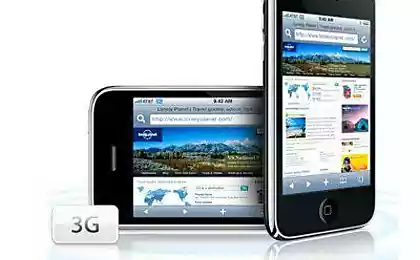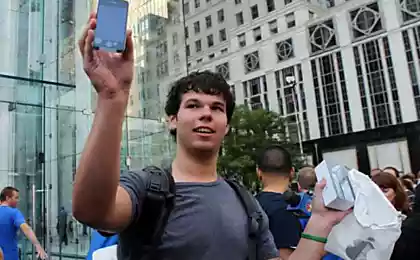1854
Apple engineers recalls the birth of iPhone
Jobs ultimatum: either you develop the concept of fast, or you lose the project. I> h4>
9,120,384
Steve is iPhone in San Francisco, January 9, 2007 i>
In February 2005, Ctiv Jobs (Steve Jobs), CEO of Apple , delivered an ultimatum to Greg Christie (Greg Christie), a senior software developer.
Mr. Christie team for months fought on the concept of software development of the product, which in the future was going to be the iPhone, as well as about how its parts work together. A little later, Jobs announced the team that they have two weeks or it will give the project to another group of developers.
"The project was almost finished, Steve almost held it in his hands," - said Christie, who still heads the team that developed the user interface. "But he wanted more original ideas, a breakthrough concepts."
Team Christie gave a variety of iPhone features such as a touch phone unlocking, call a contact from the address book, touch music player. Developers abandoned the traditional keyboard, inherent advanced phone, replacing it with a display that occupied the entire surface of the phone, and the programs it supports, were more like a program for the PC.
Mr. Christie has never publicly distributed on the first developments iPhone. But at Apple, he was allowed to talk about them on the eve of the trial with Samsung Electronics for patent infringement to make a stop on the main elements of its legal strategy - to show how innovative product was iPhone already in 2007, when born.
Since then, Apple has sold more than 470 million iPhone. Now this phone is the cause of patent litigation worldwide between Apple and Samsung, the two largest and most successful manufacturers of smartphones. , Apple claims that Samsung engineers have copied their design and functional features, while the Samsung claim that many of the innovative features of the iPhone and iPad, Apple does not have exclusive rights.
At the last hearing before the District Court in San Jose, California, Samsung ordered to pay Apple $ 930 million for infringement of patents of other companies. Concern Samsung is trying to appeal the decision.
The next stage begins on Monday. Apple is insisting that Samsung violated more than five of their patents, including the function of unlocking the phone by holding your finger on the screen («slide to unlock»), the inventor of which is directly Christie. Concern Samsung in turn accuses Apple of violating two of its patents. At this time, the amount of compensation may be greater than in the previous proceedings, since This case concerns a feature of recent models, which were sold at a higher level.
A company spokeswoman declined to Samsung any comments.
In 1996, Christie came to Apple and joined the team of developers of a personal digital assistant Newton, which was equipped with a touch screen and stylus to control, but was sold a short time. Newton device a little ahead of its time - to his contemporaries it was too big, too expensive, with Freeze software. Despite the failure, Christy kept enthusiasm about the potential of a powerful computing device fits in your pocket.
At the end of 2004, when Christie was working on software for computers Macintosh, Scott Forstall (Scott Forstall), the oldest member of the software development team, went to his office, closed the door and asked if he would like to take part in a secret project code-named «purple». The team will develop a touch phone with built-in music player.

The system created by Apple for the first test versions of the iPhone software in 2006. It is connected with a plastic device touch screen (codenamed «Wallaby») to older computers Mac, to simulate the slower speed of the hardware phone i>
By the time Jobs revived Apple and the company's work has focused around key products, including also the iPod. Dzhosvyak Greg (Greg Joswiak), vice president of marketing for Apple's iOS and the iPhone, watch for signs of other manufacturers to develop mobile phone with an integrated music player that threaten the success of iPod.
Christie engineer team pored over the details such as the ideal speed of scrolling lists on the phone and the natural effect "rebound" when the list ends. He added that his team had broken his head over how to change the appearance of text messages - to turn a list of individual messages in chronological order in a series of individual lengthy conversations like Instant Messaging on your computer.
According to Christie's, the team was "strikingly small." Apple has refused to specify the number of developers.
For several months, Christie once every two weeks preparing presentations for Jobs at the meetings in a special room with no windows on the second floor of the Apple headquarters in Cupertino, California. To этой room have access calculate the number of people, there were not even allowed to janitorial staff.
The next day after the team Christie still managed to impress Steve Jobs of his version of the software for the iPhone, they had to repeat the same presentation for Bill Campbell (Bill Campbell), Apple CEO Steve Jobs and the trustee.
A few days later, Jobs invited the team for the third demonstration, this time for Jonathan Quince, chief designer of Apple. Mr. Quince team engaged in the development of glass for the future of the smartphone. "He was interested in how we were going to do the trick c management software," - says Christie.
With each subsequent demonstration Jobs took on more and more of the story, making it their own. "His delight knew no bounds" - says Christie.
So complete was the secrecy requirement Jobs. He ordered those employees who work on the project is not in the office and at home, use a computer located in a secluded part of the house, so that no one accidentally saw the details. He also demanded that the officers scrambled digital imaging devices.
When in early 2005, was given the green light, a process that Christie calls "marathon length of two and a half years." During this time they rethink anew every detail: from checking voice mail to display the calendar. Jobs was obsessed with every detail.
In late 2006, a few months before the official presentation of iPhone, CEO asked Christie, cover any albums best demonstrate the capabilities of the technology «cover-flow» - options for viewing images on the screen. Jobs needed an album cover, made in bright colors and with a lot of people to emphasize the advantages of the display iPhone.
For the six months preceding the entry iPhone on sale in June 2007, a team of Christie made a number of changes to the project. Jobs at the insistence they got rid of split screen into two areas while viewing e-mail, where on one side contained information about the sender, and on the other - the message itself. "Steve thought it silly to divide the screen into such a small display," - says Christie.
Christie said that in the seven years of work on the iPhone, one moment remembered most clearly. A few days before the speech Jobs Christy entered the conference room through the back door, using two different badges, threw a dense curtain and on the screen in a dark room I saw a giant image projection desktop iPhone. At that moment, as he says, he realized what a great future for iPhone.
"It shines in this vast space," - shares memories Mr. Christie. "My heart sank, and I thought, and that's really going on."
Source: habrahabr.ru/company/celecom/blog/225759/
IBM Watson: where and are now used as the possibility of a supercomputer?
Video shocking the entire internet !!!






